All Aboard Hamburg’s Floating Wunderkammer
 Harry’s Harbor Bazaar is a strange collection of masks, carvings, puppets, and figurines from all over the world, carried by sailors back to Hamburg in exchange for cash. (Or, in some cases, beer.) (All photos: Michael Scott Moore)
Harry’s Harbor Bazaar is a strange collection of masks, carvings, puppets, and figurines from all over the world, carried by sailors back to Hamburg in exchange for cash. (Or, in some cases, beer.) (All photos: Michael Scott Moore)
The weirdest thing about Harry’s Harbor Bazaar, in Hamburg, isn’t the maze of musty shelves holding African masks and voodoo dolls, homoerotic New Guinean figurines, or century-old shrunken heads. The weirdest thing is how familiar it all feels, how it knocks on the brain with a set of bone knuckles, like a memory from the uncomfortable past.
Harry’s has been established in Hamburg since 1954, when Harry Rosenberg converted his modest stamp-and-coin shop into a museum of exotic things handed down from an old sailors’ pub.
The collection has changed ownership, and location, several times, most recently in 2013–right now it floats in a converted crane ship in Hamburg’s Harbor City. Caro Uhde opens it every weekend for visitors. She charges five euros to wander the aisles built into the hull. The items have no information cards, because in too many cases no one can say where they’re from.
Not just laughing wooden masks but painted shields and spears; red-faced grinning devils; buck-toothed carvings of men; headless figures of women, depicted with giant phalluses; one brass and one wooden statue of the same naked, swaying Hindu goddess; fetish faces made of colored beads and palm-frond hair; and stuffed jungle creatures–including a lifelike chimpanzee with a hat of magenta feathers–loom out at you like figures from a clichéd but terrible dream.
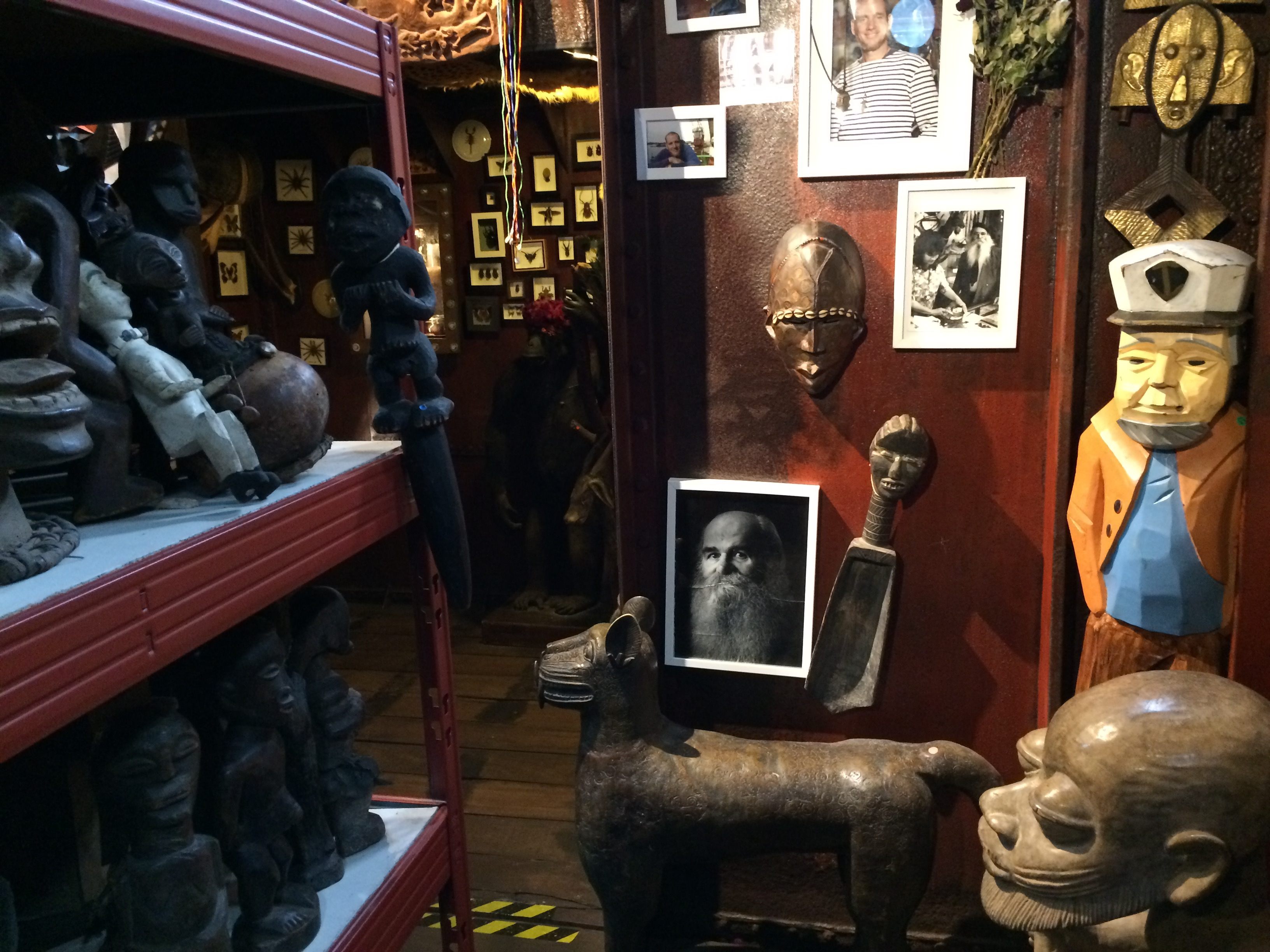 Harry Rosenberg (bearded portrait, center) founded the museum-shop in 1954. He started with items from a Hamburg sailors’ pub, and continued the pub owner’s tradition of buying curiosities from sailors.
Harry Rosenberg (bearded portrait, center) founded the museum-shop in 1954. He started with items from a Hamburg sailors’ pub, and continued the pub owner’s tradition of buying curiosities from sailors.
The ship lists while you walk around. The aisles smell like moldy rope and old wood. A memory rattles in the visitor’s brain–wasn’t there a song of some kind? By Tom Waits?
Ladiiieees and gentlemen –
Harry’s Harbor Bizarre is proud to present
Under the Big Top tonight
HUMAN ODDITIES!
Yes, it’s called “Lucky Day (Overture),” from the Black Rider album. The allusion to Harry’s is oblique, with a clever misspelling. The Hamburg museum has nothing to do with the circus.
Waits discovered Harry’s about a quarter-century ago, when he played a concert in Hamburg. “I think a friend of his was friends with Harry,” says Caro Uhde. “This friend said, ‘Tom, if you want to look at some really freaky stuff, go see Harry.’ He went one evening before a concert and walked through the shop with a notebook in his hand. He came the next day and looked at everything again.”
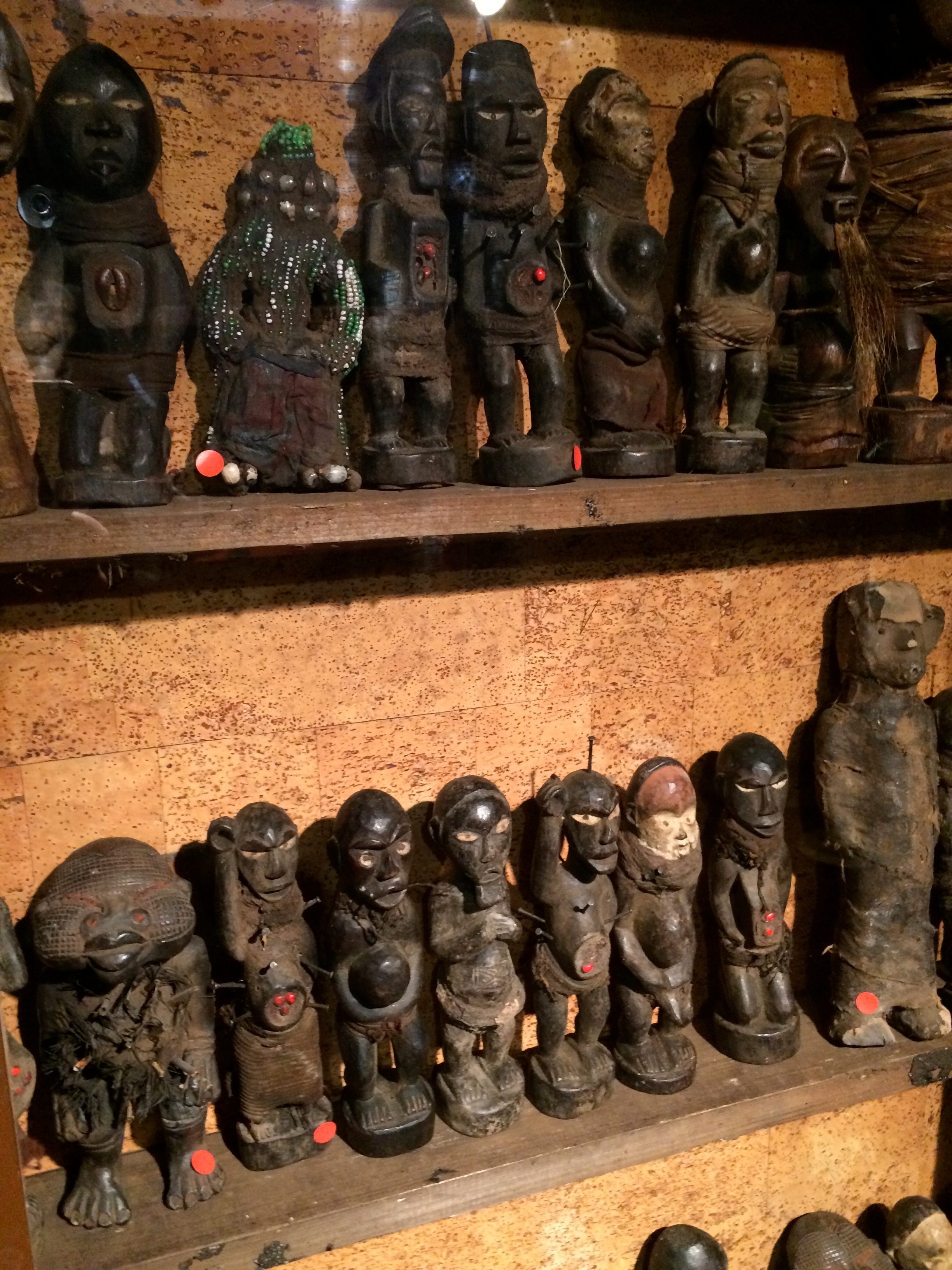
The items include West African nail fetishes — wooden figures with nails hammered in — popularly known as “voodoo dolls.”
The Black Rider came out a few years later, after Waits premiered the songs in a Robert Wilson stage show in Hamburg in 1991. The human oddities in the song didn’t spring whole from his notebooks, though. The Waits lyrics include a Three-Headed Baby, “Murtando, the human fountain,” and Hitler’s brain.
“He sings about things we don’t even have,” says Uhde with a laugh.
The origins of Harry’s collection date to the 1800s, when a bartender named Captain Haase ran a museum-pub in St. Pauli, the red-light district of Hamburg. He was an avid collector who traded overseas curiosities for beer.
“In those days people didn’t have much money,” so the captain would open a bar tab for seafarers who could bring him interesting things, says Uhde. “Or, he bought the objects outright, for cash, so a sailor could go straight to Herbertstraße, so to speak.” Herbertstraße is a street in St. Pauli known for its houses of prostitution.
 Harry Rosenberg died in 2000, and the museum-shop has moved several times. In 2013 it found a home inside a listing crane ship in Hamburg’s Harbor City.
Harry Rosenberg died in 2000, and the museum-shop has moved several times. In 2013 it found a home inside a listing crane ship in Hamburg’s Harbor City.
Old pictures of Captain Haase’s pub show a kind of ur-tiki bar hung with stuffed sawfish, mounted gazelle antlers, Polynesian totems, and at least one rabbit-sized seahorse. These cluttered and implausible nautical pubs could be found in other 19th-century seaports; you only have to read a few pages in Melville to find one. The third chapter of Moby-Dick describes the Spouter-Inn, the Massachusetts tavern where Ishmael first meets his harponeer, Queequeg:
“The opposite wall of this entry was hung all over with a heathenish array of monstrous clubs and spears. Some were thickly set with glittering teeth resembling ivory saws; others were tufted with knots of human hair; and one was sickle-shaped, with a vast handle, sweeping round like the segment made in the new-mown grass by a long-armed mower. You shuddered as you gazed, and wondered what monstrous cannibal and savage could ever have gone a death-harvesting with such a hacking, horrifying implement.”
Melville knew non-Christian people better than most American writers of his age, but Ishmael’s descriptions of “the heathen” are still cringe-inducing. Queequeg, the likable Noble Savage, is a bizarre composite who talks like a dime-novel Hawaiian and “salaams” to a “little negro idol” but wears ritual tattoos from a Pacific island called Kokovoko.
Which is nonexistent.
Like the museum cards at Harry’s.
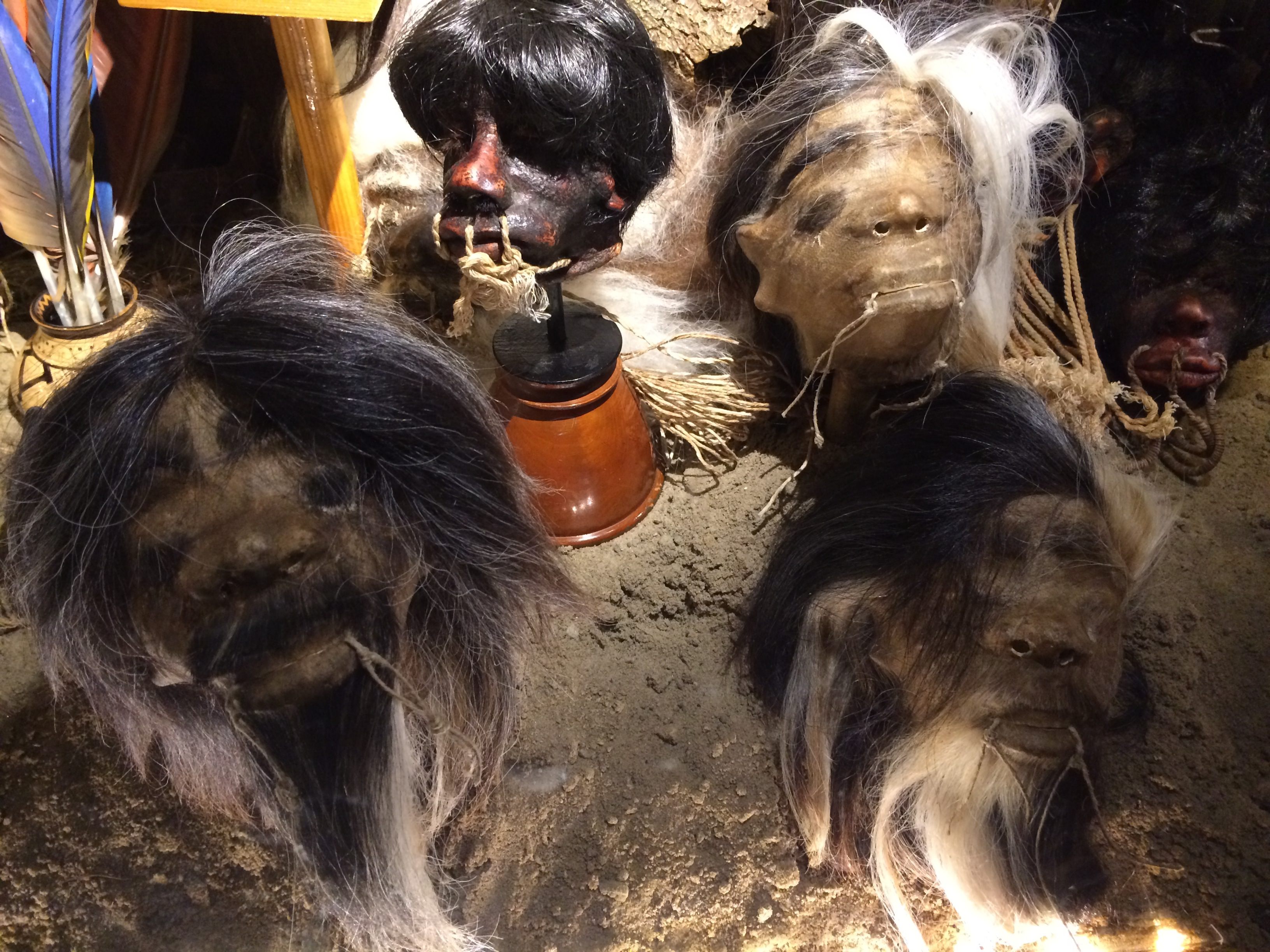 The oldest and strangest part of the collection is a case full of real shrunken heads from South America. Some of them date from the 19th century.
The oldest and strangest part of the collection is a case full of real shrunken heads from South America. Some of them date from the 19th century.
Captain Haase died in 1934, and his collection sat in storage for years until Harry Rosenberg, who was an ex-sailor, opened his stamp-and-coin shop, also in Hamburg. The captain’s heirs agreed to let Harry buy some of the old pub collection to liven up his walls. The idea worked too well–Harry’s décor upstaged the coins and stamps. More and more of his customers wanted to see, and buy, the weird old things.
So he crammed his shop with sailors’ treasure and re-christened it a “bazaar” in 1954. He paid money for new exotica. He became a latter-day Captain Haase. By the time he died, in 2000, Harry was a famous local citizen and an underground symbol of St. Pauli.
“We still get sailors in here who remember selling items to Harry,” says Uhde. “One of them brought him an enormous [stuffed] crocodile, I mean really big. This was in the ’70s, and by then it was known internationally that if you needed cash, you could go to Harry. So seafarers would stuff their bunks so full that they had to sleep on the items. In the ship! They didn’t have much room. And this man slept on his crocodile.”
Some of the items look like tourist tat. Others–like some Indonesian wayang marionettes–are worth “one hundred euros and up, without limit,” depending on condition, says Uhde. Professionals have studied and appraised most of the collection. “But we really have a lot of things here that we just can’t place.”
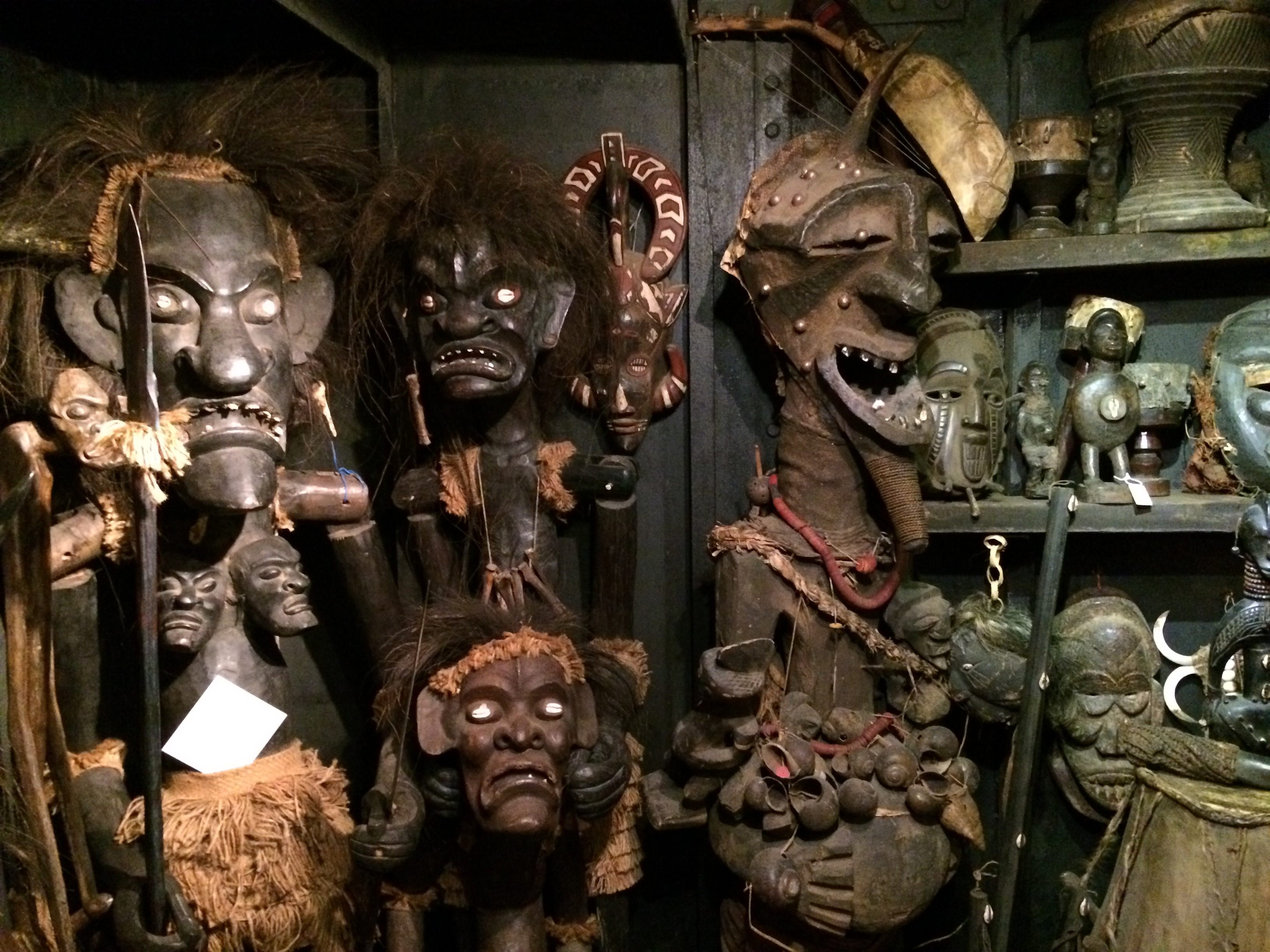 Some items are beautiful and rare; others just tourist souvenirs. But the collection is weird enough to warrant mention in a song by Tom Waits.
Some items are beautiful and rare; others just tourist souvenirs. But the collection is weird enough to warrant mention in a song by Tom Waits.
The rooms work as categories for all the clutter. First you walk through the “Chamber of Anterior Asia,” then the “Chamber of Ulterior Asia,” then past the chimpanzee with the funny hat. The oldest items may be the shrunken heads–horrible wads of human leather with scrunched faces and wild tufts of hair. They date from Captain Haase’s time.
There’s a room full of “voodoo dolls,” actually West African nail fetishes, or wooden figures with nails driven into them. According to some Congolese tribal traditions a healer could invest these figures with spiritual energy. The energy could be activated at any time by hammering in a nail. It might ward off evil, heal an ailment, or punish a person who had sworn an oath on the little statue.
“Most people think of voodoo dolls as cushions stabbed with pins to get revenge, but that isn’t real,” says Uhde. “We have the real kind.”
The rudest item might be an exaggerated, stretched-looking wooden figure of a naked man, with low-hanging balls, sucking another man’s limp, low-hanging penis. Uhde says it’s from New Guinea.
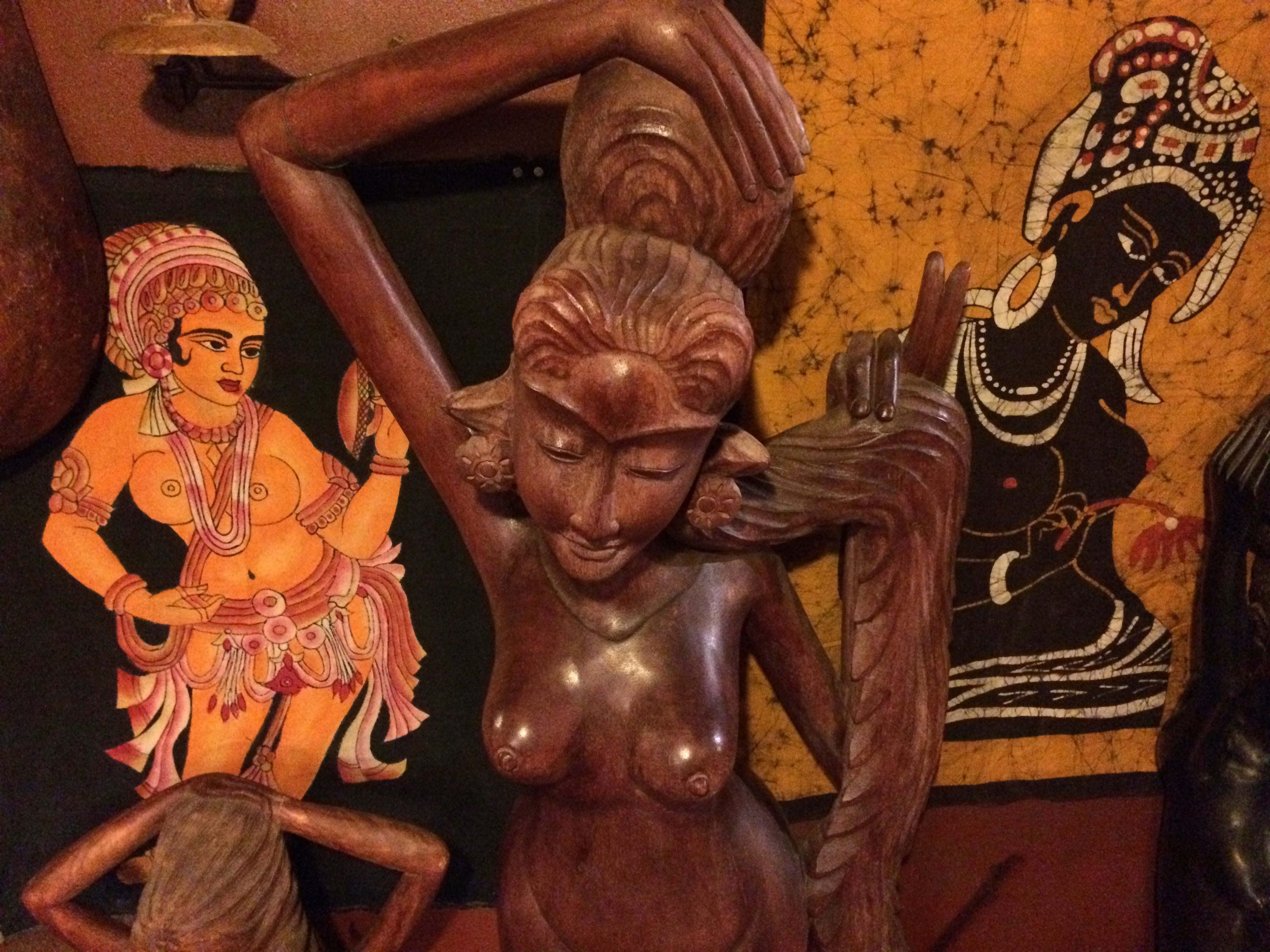 The museum is categorized by region — Africa, Southeast Asia — but pinning down the provenance of each item has proved impossible.
The museum is categorized by region — Africa, Southeast Asia — but pinning down the provenance of each item has proved impossible.
“Homosexual figures have always existed, but it’s a taboo topic,” says Uhde. “Some of ours were carved so people could burn them–in other words to exorcise homosexual feelings.”
Homosexuality isn’t taboo in some parts of New Guinea. Tobias Schneebaum describes certain examples, from personal experience, in his remarkable 1988 travelogue Where the Spirits Dwell. But taboos differ from tribe to tribe, and Uhde says the figures at Harry’s were meant for the flames.
“They were rescued, in a sense,” she says. “They were supposed to be burnt, but a seafarer brought them out.”
The vision of exoticism on display at Harry’s is so fusty it’s almost offensive; a visitor too sensitive to whiffs of Orientalism will hyperventilate. But the real shame is the muteness of the shelves. How did everything get here? The honest story of a single item might fill a chapter in a book. At last count the full inventory held more than 350,000 pieces, most of them in a separate warehouse, which makes the chorus of silence at Harry’s far more terrible than all the laughing masks.

























Follow us on Twitter to get the latest on the world's hidden wonders.
Like us on Facebook to get the latest on the world's hidden wonders.
Follow us on Twitter Like us on Facebook